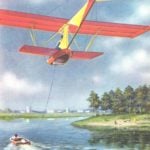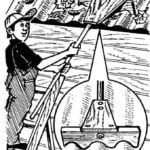 In 1936, the British firm Vickers-Armstrong, the initiative has begun to develop a light reconnaissance tank, designed to replace the light tank Mk.VI, did not meet the military mainly in terms of weapons. The design of the new machine was carried out under the direction of engineer Leslie little. The new tank differed sharply from all previous models of the firm and embodied many revolutionary ideas tank builders.
In 1936, the British firm Vickers-Armstrong, the initiative has begun to develop a light reconnaissance tank, designed to replace the light tank Mk.VI, did not meet the military mainly in terms of weapons. The design of the new machine was carried out under the direction of engineer Leslie little. The new tank differed sharply from all previous models of the firm and embodied many revolutionary ideas tank builders.
Feature of the tank, without a doubt, was the design of the chassis. For control was used the steering column of automobile type. Rods turned bottom rollers and the drive wheels and the second and third rollers also deviated from the vertical axis. Caterpillar the result is curved in an arc, and the tank turned in one direction or another without braking and reducing speed. Road wheels had rubber tires. Suspension—hydropneumatic.
The body of the tank going to the frame from the corners with rivets. In the front sloping plate was a small cabin, covering the head and shoulders of the driver. The entire front part of the wheelhouse can be opened, the driver got a good overview, but when the hatch was closed, he was able to monitor only through a small observation slit. The turret also carried out riveted, was spacious enough, but had no part and did not provide the commander a satisfactory review. In addition, the commander had to perform more functions of loader.
Horizontally-opposed gasoline 12-cylinder engine Meadows MAT with a power of 165 HP at 2700 rpm and five-speed gearbox Meadows Round 30 allowed the military machine weight 7.62 t to develop a speed of 64 km/h on the highway and 45 km/h on a country road. Booking was easy, and it was not surprising, since the main goal of the designers was the speed. However, the car had armor on par with other light tanks of that time—from 4 to 16 mm.

Light tank “Tetrarch” during the test NIBT on the ground in Kubinka. 1946
Armament consisted of standard English 2-pound (42-mm) gun Mk.lX and coaxial 7.92-mm machine gun BESA. On the right and left side of the turret was fastened by one smoke grenade launcher caliber 101.6 mm. ammunition of the tank consisted of 50 shots, 2025 rounds and eight smoke grenades. Such powerful weapons, unusual for light tanks of those years, became the reason for the delay in making the machine into service. Weight and armor protection of the tank corresponded to the class of light tanks and weapons — cruising. Eventually the tank was classified as “easy cruising” and on June 23, 1938, adopted the called the Light Cruiser Mark VII (A17). A year later the car received a proper name— Tetrarch (“Tetrarch”).
At that time the maximum speed of the machine was very high and, according to designers, Mk.VII was to become a powerful and speedy reconnaissance tank, able to move quickly across the battlefield and, if necessary, to conduct reconnaissance. However, the war Department put this principle in doubt just the time of the appearance of the first prototype, because the experience of war in Spain showed that light tanks had fallen short of expectations. For this reason, the order of Mk.VII was signed only in late January 1939.

Light tank Mk VII “Tetrarch”:
1-2 pounder gun; 2 — smoke grenade; 3 — louver air intake; 4 — additional fuel tank; 5—a box of ZIP; 6 —a cover of the hatch door; 7 — surveillance device MK IV; 8 — searchlight; 9—Besa coaxial machine gun; 10— engine; 11 —the flip cover of the driver’s hatch; 12 — louver air outlet; 13 — mufflers

Diagram of the device steering:
1 —drive; 2—front control gears; 3—long rods; 4—inner tie rods; 5 — internal control gears; 6— gearboxes management

The office:
1 —steering wheel; 2—thermometer; 3—tachometer; 4—signal; 5—fuel tank; 6 — brake pedal; 7—accelerator; 8 — battery; 9—the lever of a hand brake; 10—seat driver; 11—the steering column; 12 gearshift lever; 13 — instrument panel; 14 — a coupling pedal; 15 — fuel tank; 16 — ammeter; 17 — a speedometer; 18 — oil pressure indicator
The production of “Tetrarchic” was carried out at the plant of the company Metropolitan Carriage, Wagon and Finance Co.Ltd in Birmingham and moved pretty slowly, partly because there were a lot of problems with unusual suspension, partly because of damage caused to the plant by German aircraft. The first production light tanks Mk.VII came from the factory in November 1940. In the winter of 1941 the first of these machines were the 9th lancers, in which they were used as trainers. For training purposes “Tetrachy” was used in other parts of the British army, as the armed reconnaissance units instead of light tanks began to receive armored vehicles. Unsuccessful attempt to use Mk.VII in North Africa. These tanks had a failing cooling system of the engine, which was made unfit for use in desert conditions. For these reasons, the army to “Tetrarch” had cooled. After the release of 177 military vehicles manufacturing it in 1942 stopped.
In 1942 under lend-lease 20 “Tetrarchic” arrived in the Soviet Union. 19 of them were part of the Soviet units and formations and used the fighting during 1943.
In the summer of 1942 “Tetrarch” was received from 9th lancers regiment of the British army, first in training camp in Sumgait, and in November — in the 151-th Soviet tank brigade (45th army of the Transcaucasian front, Leninakan). Team 24 T-26 and MK 19.VII (this is the spelling of the brand of the tank found in Soviet documents) engaged in the protection of the state border of the USSR and communications in Northern Iran, which were delivered the goods to our country. On 5 January 1943 the brigade was deployed in Tuapse and made available to the 47-th army (the black sea group of the Transcaucasian front).
19 Mar 14 “Tetrarchic” (four of them faulty) was transferred from the 151st tank brigade to 563-th separate tank battalion, in service which at that time consisted of two BT7, two T-34, two T-26 and two T-60, single “Valentine” and one Mzl. According to the military command of the commander of armored and mechanized troops of the 18th airborne army from March 25, 1943, the platoon, consisting of four MK.VII with three shells and two fuel stations were assigned to the 3rd infantry corps. In March—April in the area Shapsugskogo bridge these tanks were used as stationary firing points.

Light tank Mk VIII “Harry Hopkins”

Soviet tank crews are learning English tank MK VII. 151 tank brigade, 1942. The tower and the machine frame caused the rooms of the British war Department
At the end of may 1943, the remaining on the go seven tanks handed over to the 132-th separate tank battalion. In June, the commander of the battalion sent to the headquarters of the army report, which reported that “a material part of the tank “Vickers” MK.VII are worn out and spare parts for these tanks no army, no bases for repair the front…”. September 14, 1943, the remaining material part 563-th separate tank battalion (including two serviceable “Tetrarch”) was transferred to the 5th guards tank brigade. One MK.VII was shot down in combat on 29 September and 1 October 1943 and the second one received a direct hit by an enemy shell and burned to the position. This ended the battle path “Tetrarchic” in the red Army.
With regard to the latter—twentieth of the Tetrarch, it was sent for testing Nicholoson in the Moscow suburb of Kubinka. Here the tank was subjected to a comprehensive inspection. Among the advantages of the Soviet experts attributed the ease of operation, good mobility, and maneuverability. The tank was quite pretentious to the type of fuel used. But, of course, had weak book. Attempts to equip it with additional armor plates failed as loaded a tank lost its mobility and permeability, and the engine while driving without roads overheat. Without additional armor, firepower and mobility of the tank Mk.VII was comparable with the T-26, BT and T-70 with less weight. Currently this tank is in the exposition of the Military historical Museum of armored vehicles and armament in Kubinka.
Several tanks “Tetrarch” took part in operation Ironclad (“Battleship”) — the invasion, on 5 may 1942 on the island of Madagascar, which was controlled by the French Pro-German Vichy regime. The tanks were part of a squad of special purpose “In the” 29th Indian brigade. The French quickly surrendered, and “Tetragram” did not have to participate in major battles.
To the creation of the airborne forces in the UK started under the impression of the successful actions of the German paratroopers in Norway and the Netherlands. For use as a airborne tank, was elected as “Tetrarch”. To transport the company General Aircraft Ltd. created by a 16-ton glider “Hamilcar”, which had a hinged nose and a ramp. The crews were in the tanks, and after landing combat vehicle immediately left the gliders. “Hamilcar” usually towed by bombers “Halifax”.
The largest battle scene in the fate of the “Tetrarchic” refers to D-day — the beginning of the allied landings in Normandy on 6 June 1944. They were part of the 6th airborne reconnaissance regiment of the 6th English airborne division. During the flight over the English channel the bow of one of the gliders appeared and the tank with its crew fell into the water. Eight tanks were included in the second wave of troops and had to attack the bridge over the river Orne. Most of the “Tetrarchic” after landing confused its tracks in parachutes and was not involved in combat. Eight more tanks were landed from the sea. Soon almost all “Tetrarch” in the 6th airborne division was replaced by the “Cromwell”.
Last time during world war II “Tetrarch”, together with the us M22 “locust”, was used in crossing the Rhine March 24, 1945.
In June 1941, was built as a floating version of the tank “Tetrarch”. This modification was equipped with a system that ensures switching of the motor to the drive screw, located on the external side of the elevating screen. In a variant of the “Tetrarch” DD was a converted single tank, which was used as a test stand.

Light tank Mk VII “Tetrarch”. 9th lancers of the British army. 1942

Light tank Mk VII “Tetrarch”. 151 tank brigade of the red Army. Transcaucasian front, 1942

Light tank M22 “locust”. The 28th airborne tank battalion of the U.S. army. Fort Knox, 1943 (read about it in “M-K” № 8, 2007)
Several tanks were converted into a version of CS (direct infantry support): staff replaced the gun 76 mm howitzer. It should be noted that from 1944 to increase armor penetration 2 pounder guns the last was equipped with a nozzle adapter, Little John (“Little John”), the initial velocity armor-piercing projectile was increased to 1200 m/s, but the speed is very fast down, and fire on the German medium and heavy tanks was only possible from close range.
It may seem incredible, but the fact remains that the British war office, thoroughly knowing all the weaknesses of the Tetrarch, ordered a new tank, the design of which was based on the same principles. In 1941 the Vickers built three prototype light tank from the Mk.VII. Modification received the official designation Mk.VIII the name “Harry Hopkins”. By construction, the tank resembled a “Tetrarch”, but had a simplified welded hull with heavily sloped frontal armor a one-piece sheet, whose thickness had reached 38 mm. the Side walls welded turret, lower than “Tetrarch” had a rational angles. The armament remained the same at combat weight of 8.6 t. But the main thing — the availability of power steering, which greatly simplified the management of the tank.
“Harry Hopkins”, was interested in the military for two years it was expected to produce 1,200 vehicles of this type. However, after the release of the 99 tanks were discontinued and they never participated in the fighting: immediately after the manufacture of the tanks entered for warehousing. “Harry Hopkins” — the latest development of light tanks in the UK during the Second world war. These war machines do not fit within the framework of the concept of airborne tanks, because the real can only perform reconnaissance missions. Use them to fight enemy tanks was simply impossible.
In turn, the “Harry Hopkins” was the basis for the creation of self-propelled artillery “Alecto” (the original title was”Harry Hopkins” Mk.l CS), developed on the basis of the technical conditions that were put forward English the General staff in April 1942. Its design included the possibility of installing 6-, 25 – and 30-pound guns. SAU “Alecto” armed with a 95 mm howitzer, manufactured at Vickers, right after the end of hostilities. Combat tower was open from top, the gun was mounted in front of the compartment. Chassis and powerplant borrowed from the tank “Harry Hopkins” unchanged. “Alecto” was for its time a good self-propelled gun, but in connection with the termination of the war was no longer needed. All attempts by the firm Vickers to any order for its production failed. Only one machine is purchased Switzerland.
After the war, “Tetrarch” and “Hopkins” little time was used for training purposes. However, their service was short-lived and by 1948 they were all in warehouses.
M. KNYAZEV



